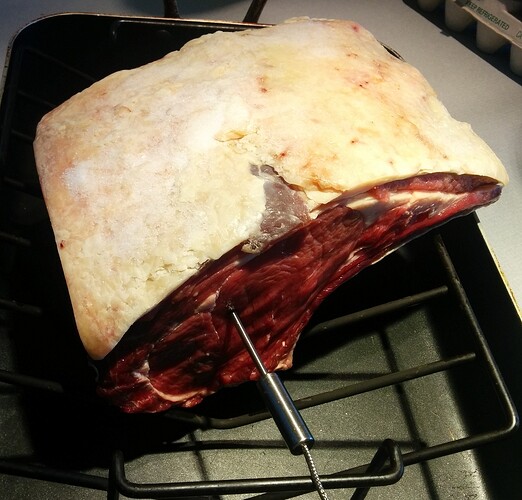Notes from past years:
2006:
18-pound six-rib roast in at 450F, probe read 59F. After 20 minutes reduced the heat to 250F. The probe reached 118F at 3’24". So not counting the initial searing, that was just over ten minutes per pound.
2009:
22-lb. Seven-rib dry-aged Niman, additional dry aging by the butcher (Cafe Rouge, Berkeley), fat cap removed, chine bone removed, presalted, fat cap tied back on. Same method as above. Probe read 60F before cooking. The new oven apparently runs a bit hot when set to 250F (though it was spot on at 450F), and I had convection on, so it was done in a hair over three hours, or a bit over eight minutes a pound. Fabulous results especially considering next to no effort on my part.
2012 [edited to correct weight]:
14-lb. five-rib, dry-aged at least 42 days, maybe longer. The butcher said by that point the fat cap is nasty and if he didn’t remove it would give the roast an off flavor. Unfortunately that was at 3pm on Christmas Eve, so it was too late to get a fat cap from a younger roast, so I just roasted as is.
Rubbed with around 2.5 tablespoons of salt and let sit overnight. Salt had not been completely absorbed so I sponged it off. I guess after such long dry-aging it takes longer.
Internal temperature was a little over 60 when I put it in the oven at around 1:45. Set the oven at 200 but the digital thermometer said it was about 25 degrees lower, so turned up to 225. Reached 117 in a little under 3.5 hours.
I wrapped it in aluminum foil and a towel and put it in a box to take to our friends’ house. When it was time to carve it maybe two hours later it had reached 135, a little more done than I wanted. I blasted the fat with a kitchen torch to crisp it.
Needed a little salt, otherwise turned out great.
2013:
8.5-lb. 4-rib Piemontese (Macgruder?) from Cafe Rouge. Despite my instructions to tie the fat cap back on they threw it out and trimmed the roast within an inch of its life, leaving no fat at all on some parts. Rubbed with 2 tbsp. salt the night before. They gave me some caul fat and I put that over the bare parts.
Probe read 63 when I put the roast into a cold oven. Roasted around 210 and it hit 117 in two hours.
Flavor was mild and somewhat disappointing, maybe because they switched from Niman to grass-finished. I guess I have to find a new source next year.
2014:
11-lb., four ribs from the big end. 53 degrees when it went in, roasted around 225, hit 122 in 4-1/4 hours. Clearly the starting temperature makes a big difference. This year I took it out of the fridge in the morning instead of the night before.




